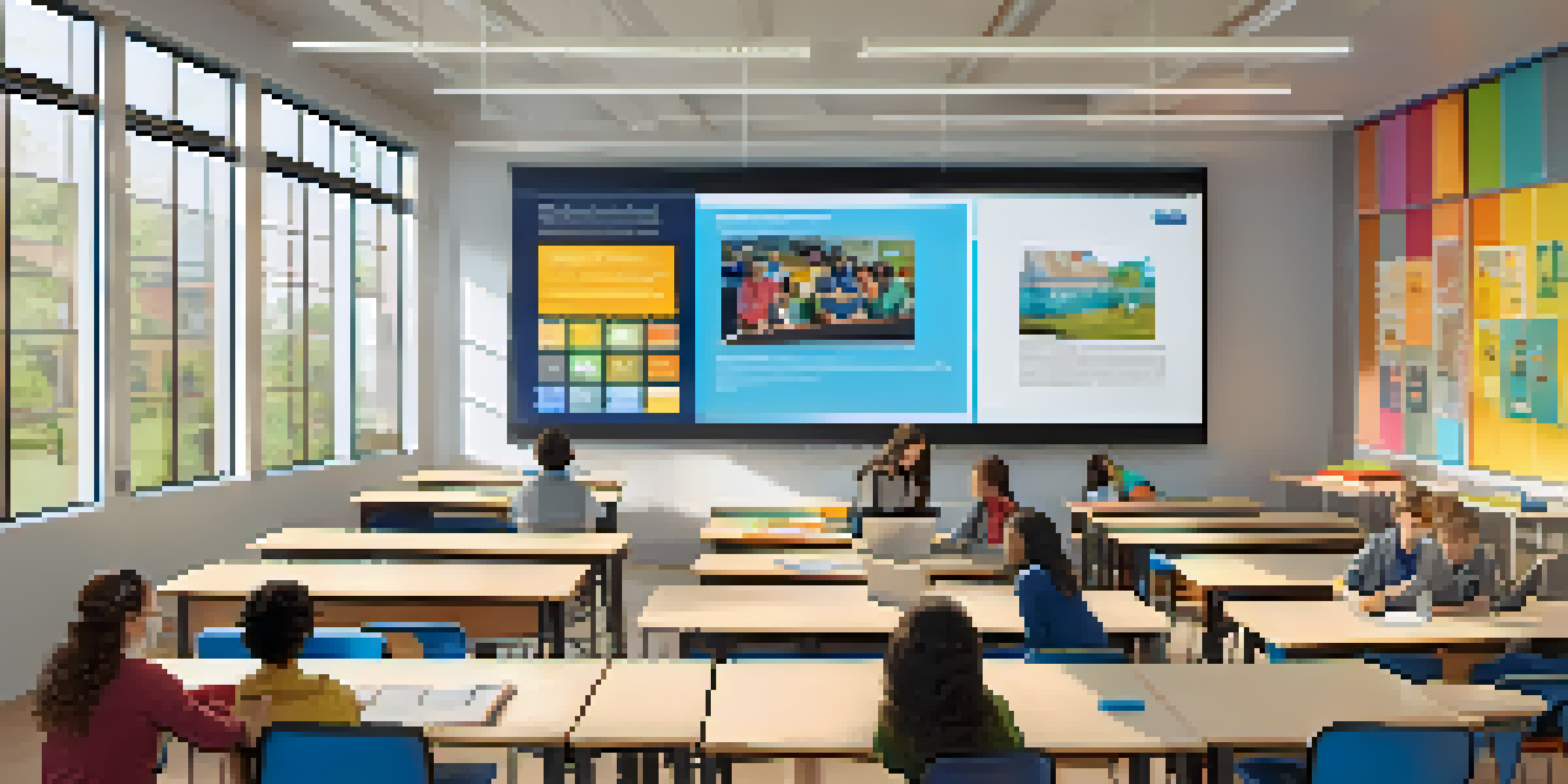Exploring the Benefits of Hybrid Learning Models in Education

Understanding Hybrid Learning Models in Education
Hybrid learning is an educational approach that combines traditional face-to-face teaching with online learning. This model allows students to benefit from the personal interaction of classroom settings while also enjoying the flexibility that online resources offer. Think of it as a delightful blend of the old-school classroom vibe and the modern digital experience, creating a dynamic learning environment.
Hybrid learning is the future of education, blending the best of both worlds to create a personalized learning experience.
In a hybrid learning model, educators can utilize various online tools to enhance their teaching. For instance, a teacher might conduct lectures in class while assigning interactive quizzes or discussion forums online. This fusion not only caters to different learning styles but also encourages students to take charge of their own learning journey.
Ultimately, the goal of hybrid learning is to create a more personalized education experience. By leveraging both in-person and online methods, educators can better address the diverse needs of their students, making learning more effective and engaging.
Flexibility: A Key Advantage of Hybrid Learning
One of the standout benefits of hybrid learning is its inherent flexibility. Students can access course materials and complete assignments at their own pace, fitting their studies around other commitments such as work or family. This flexibility is especially beneficial for adult learners who may juggle multiple responsibilities.

Imagine a college student who works part-time while pursuing their degree. With hybrid learning, they can attend in-person classes twice a week and complete the rest of their coursework online. This arrangement allows them to manage their time effectively, reducing stress and improving their overall academic performance.
Hybrid Learning Offers Flexibility
Students can balance their studies with personal commitments, allowing for a more manageable educational experience.
Furthermore, this flexibility extends to educators as well. Teachers can design their courses with varied pacing, tailoring lessons to the needs and progress of their students. This adaptability fosters a more supportive learning environment where everyone can thrive.
Enhanced Engagement Through Interactive Learning
Hybrid learning models often incorporate interactive tools that boost student engagement. Online platforms can facilitate discussions, group projects, and multimedia presentations, making learning more dynamic and participatory. For instance, using video conferencing tools allows students to collaborate in real-time, even from different locations.
Education is not the filling of a pail, but the lighting of a fire.
Consider a scenario where students are working on a group project. In a hybrid setup, they can meet in person for brainstorming sessions and then continue collaborating online through shared documents or chat platforms. This seamless transition between modes encourages creativity and strengthens teamwork skills.
Additionally, engaging content, such as videos, podcasts, and quizzes, can be integrated into the online portion of hybrid classes. By providing varied learning materials, educators can capture students' interest and cater to different learning preferences, leading to a richer educational experience.
Personalized Learning Experiences for Students
Hybrid learning allows for a more personalized approach to education, accommodating individual learning styles and paces. Students can choose when and how they engage with the material, whether through watching recorded lectures or participating in live discussions. This autonomy empowers them to take greater control of their learning.
For example, a student struggling with a particular concept can revisit an online lecture as many times as needed, ensuring they fully grasp the material before moving on. This level of personalization is often challenging to achieve in traditional classroom settings, where the pace is often dictated by the majority.
Engagement through Interactive Tools
Incorporating online platforms enhances participation and collaboration, making learning more dynamic.
Moreover, teachers can use data and analytics from online platforms to gauge student performance and adjust their teaching strategies accordingly. This real-time feedback loop allows for timely interventions, ensuring that no student falls behind.
Cost-Effectiveness of Hybrid Learning Models
Another significant advantage of hybrid learning is its cost-effectiveness. By blending online and in-person instruction, educational institutions can reduce expenses related to physical resources, such as classroom space and materials. This can lead to more budget-friendly tuition options for students.
Consider how online resources can replace traditional textbooks, which can be expensive and quickly become outdated. In a hybrid model, students can access digital materials that are often more current and affordable. This shift can make quality education more accessible to a broader audience.
Additionally, for institutions, the ability to reach more students through online offerings can lead to increased enrollment without the need for additional physical infrastructure. This scalability opens up new opportunities for schools and universities to thrive in a competitive educational landscape.
Preparing Students for a Digital Future
In today’s technology-driven world, hybrid learning helps prepare students for the digital landscape they’ll encounter in their careers. By engaging with various online tools and platforms, students develop essential digital skills that are increasingly sought after by employers. It’s like training for the modern workforce while still in school.
For instance, students might become proficient in using collaborative software, managing online projects, or communicating effectively in virtual environments. These skills are not just beneficial for academic success; they are invaluable for future job opportunities across numerous industries.
Personalized Learning for Everyone
Hybrid models accommodate individual learning styles, enabling students to take control of their education.
Furthermore, hybrid learning encourages adaptability—a crucial trait in an ever-evolving job market. As students navigate both online and in-person learning experiences, they become more comfortable with change and uncertainty, preparing them to thrive in their future careers.
Challenges and Considerations in Hybrid Learning
While hybrid learning offers numerous benefits, it's essential to acknowledge the challenges that come with it. One major concern is the potential for unequal access to technology, which can create disparities among students. Not all learners may have reliable internet connections or devices, leading to a gap in participation.
Additionally, some students may struggle with self-discipline in an online learning environment. The absence of a structured classroom setting can make it difficult for them to stay focused and motivated. Educators must find ways to support these students, fostering accountability and encouraging engagement.

Finally, developing a cohesive curriculum that seamlessly integrates both online and in-person components can be complex. Teachers need to invest time and effort into planning and delivering content effectively across different formats, ensuring that students receive a well-rounded educational experience.
The Future of Education: Embracing Hybrid Learning
As we move forward, hybrid learning models are likely to play an increasingly significant role in education. With technological advancements and changing societal needs, educational institutions are adapting to provide more flexible, engaging, and personalized learning experiences. This evolution is not just a response to recent challenges but a proactive approach to enhancing education.
Imagine a future where students can choose their learning paths, combining online and in-person classes in a way that suits their unique needs. This shift could lead to a more diverse and inclusive educational landscape, catering to various learning preferences and life circumstances.
In conclusion, hybrid learning models represent a promising direction for education, fostering innovation and adaptability. By embracing these approaches, we can create a more resilient education system that prepares students for the challenges and opportunities of the future.